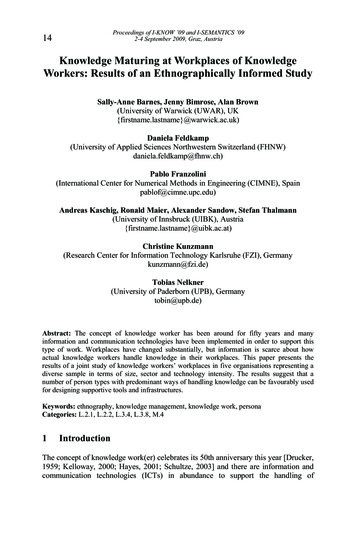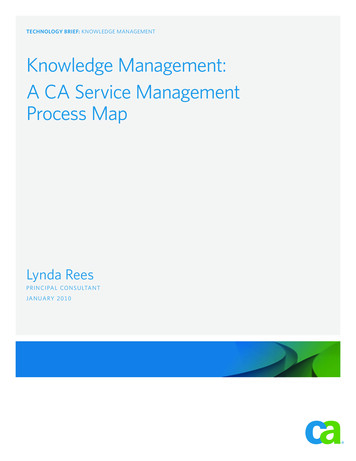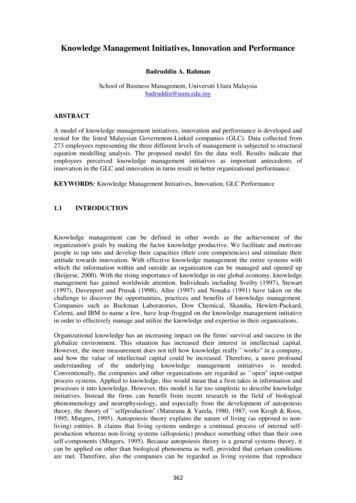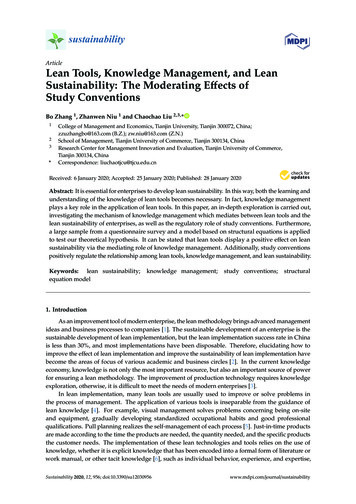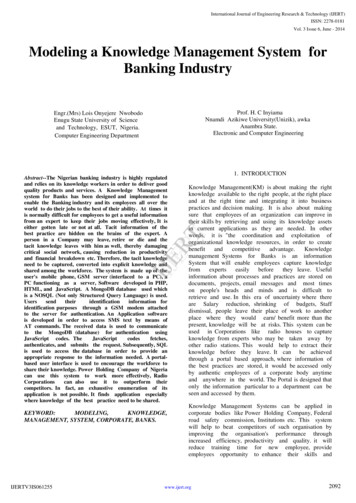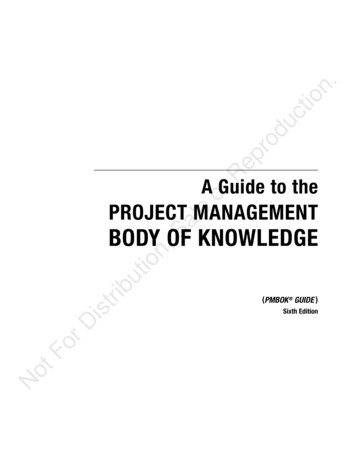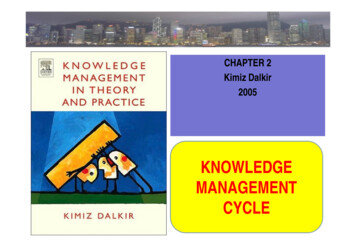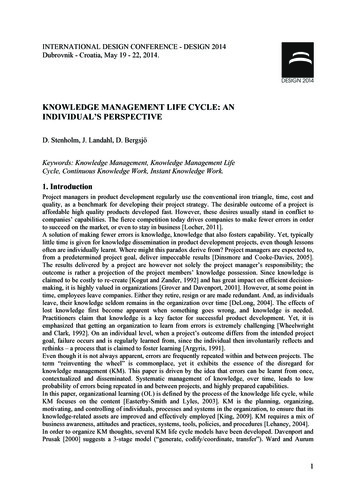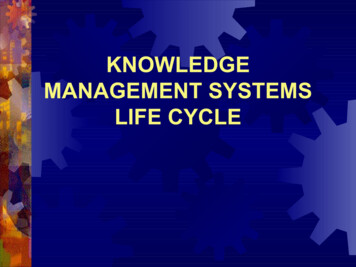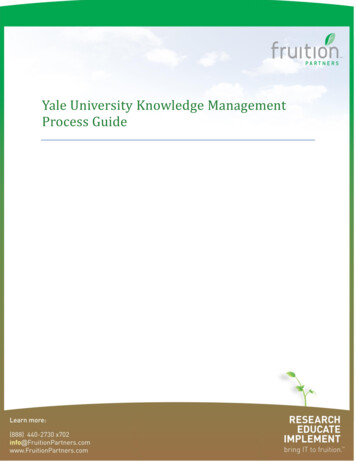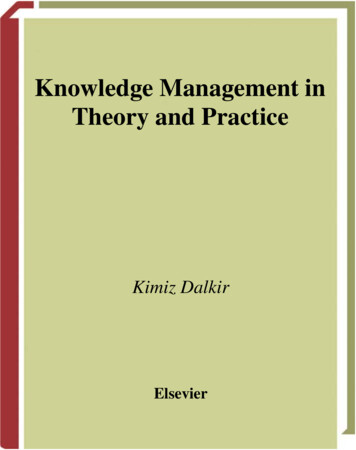
Transcription
Knowledge Management inTheory and PracticeKimiz DalkirElsevier
KNOWLEDGEMANAGEMENTIN THEORYANDPRACTICE
KNOWLEDGEMANAGEMENTIN THEORYANDPRACTICEKimiz DalkirMcGill UniversityAMSTERDAM BOSTON HEIDELBERG LONDONNEW YORK OXFORD PARIS SAN DIEGOSAN FRANCISCO SINGAPORE SYDNEY TOKYO
Elsevier Butterworth–Heinemann30 Corporate Drive, Suite 400, Burlington, MA 01803, USALinacre House, Jordan Hill, Oxford OX2 8DP, UKCopyright 2005, Elsevier Inc. All rights reserved.No part of this publication may be reproduced, stored in a retrieval system, or transmitted inany form or by any means, electronic, mechanical, photocopying, recording, or otherwise,without the prior written permission of the publisher.Permissions may be sought directly from Elsevier’s Science & Technology Rights Departmentin Oxford, UK: phone: ( 44) 1865 843830, fax: ( 44) 1865 853333, e-mail:permissions@elsevier.co.uk. You may also complete your request on-line via the Elsevierhomepage (http://elsevier.com), by selecting “Customer Support” and then “ObtainingPermissions.”Recognizing the importance of preserving what has been written, Elsevier prints its books onacid-free paper whenever possible.Library of Congress Cataloging-in-Publication DataApplication submittedBritish Library Cataloguing-in-Publication DataA catalogue record for this book is available from the British Library.ISBN: 0-7506-7864-XFor information on all Elsevier Butterworth–Heinemann publicationsvisit our Web site at www.books.elsevier.comPrinted in the United States of America05 06 07 08 09 1010 9 8 7 6 5 4 3 2 1Working together to growlibraries in developing countrieswww.elsevier.com www.bookaid.org www.sabre.org
This book is dedicated to my sons, Kemal and Kazmir, who are beginningtheir journey of discovery.
CONTENTSForewordAcknowledgements1INTRODUCTION TO KNOWLEDGE MANAGEMENTIN THEORY AND PRACTICE . . . . . . . . . . . . . . . . . .Learning ObjectivesIntroductionWhat Is Knowledge Management?Multidisciplinary Nature of KMThe Two Major Types of KnowledgeThe Concept Analysis TechniqueHistory of Knowledge ManagementFrom Physical Assets to Knowledge AssetsOrganizational Perspectives on Knowledge ManagementWhy Is KM Important Today?KM for Individuals, Communities, and OrganizationsKey PointsDiscussion PointsReferences2 THE KNOWLEDGE MANAGEMENT CYCLE . . . . . . . . .Learning ObjectivesIntroductionMajor Approaches to the KM CycleThe Zack KM CycleThe Bukowitz and Williams KM CycleThe McElroy KM CycleThe Wiig KM CycleAn Integrated KM CycleStrategic Implications of the KM CyclePractical Considerations for Managing 3538434545vii
Key PointsDiscussion PointsReferences3 KNOWLEDGE MANAGEMENT MODELS . . . . . . . . . . .Learning ObjectivesIntroductionMajor Theoretical KM ModelsThe von Krogh and Roos Model of OrganizationalEpistemologyThe Nonaka and Takeuchi Knowledge Spiral ModelThe Knowledge Creation ProcessKnowledge ConversionKnowledge SpiralThe Choo Sense-making KM ModelThe Wiig Model for Building and Using KnowledgeThe Boisot I-Space KM ModelComplex Adaptive System Models of KMStrategic Implications of KM ModelsPractical Implications of KM ModelsKey PointsDiscussion 727373744 KNOWLEDGE CAPTURE AND CODIFICATION . . . . . . .77Learning ObjectivesIntroductionTacit Knowledge CaptureTacit Knowledge Capture at Individual and Group LevelsInterviewing ExpertsStructured InterviewingStoriesLearning by Being ToldLearning by ObservationOther Methods of Tacit Knowledge CaptureTacit Knowledge Capture at the Organizational LevelExplicit Knowledge CodificationCognitive MapsDecision TreesKnowledge TaxonomicsStrategic Implications of Knowledge Capture and CodificationPractical Implications of Knowledge Capture and CodificationKey PointsDiscussion 102103104105105105viiiK N OW L E D G E M A N AG E M E N T I N T H E O RY A N D P R AC T I C E
5 KNOWLEDGE SHARING AND COMMUNITIESOF PRACTICE . . . . . . . . . . . . . . . . . . . . . . . . . . .109Learning ObjectivesIntroductionThe Social Nature of KnowledgeSociograms and Social Network AnalysisCommunity Yellow PagesKnowledge-Sharing CommunitiesTypes of CommunitiesRoles and Responsibilities in CoPsKnowledge Sharing in Virtual CoPsObstacles to Knowledge SharingThe UndernetOrganizational Learning and Social CapitalMeasuring the Value of Social CapitalStrategic Implications of Knowledge SharingPractical Implications of Knowledge SharingKey PointsDiscussion 21331341351371381391401401406 KNOWLEDGE APPLICATION . . . . . . . . . . . . . . . . . .Learning ObjectivesIntroductionKnowledge Application at the Individual LevelCharacteristics of Individual Knowledge WorkersBloom’s Taxonomy of Learning ObjectivesTask Analysis and ModelingEPSSKnowledge Application at Group and Organizational LevelsKnowledge ReuseKnowledge RepositoriesStrategic Implications of Knowledge ApplicationPractical Implications of Knowledge ApplicationKey PointsDiscussion PointsNotesReferences7 THE ROLE OF ORGANIZATIONAL CULTURE . . . . . . . .Learning ObjectivesIntroductionDifferent Types of CulturesOrganizational Culture 174175175177177178181182CONTENTSix
Culture at the Foundation of KMThe Effects of Culture on IndividualsCultural Transformation to a Knowledge-Sharing CultureOrganizational Maturity ModelsKM Maturity ModelsCoP Maturity ModelsStrategic Implications of Organizational CulturePractical Implications of Organizational CultureKey PointsDiscussion PointsNotesReferences8 KNOWLEDGE MANAGEMENT TOOLS . . . . . . . . . . . .Learning ObjectivesIntroductionKnowledge Capture and Creation ToolsContent Creation ToolsData Mining and Knowledge DiscoveryBlogsContent Management ToolsKnowledge Sharing and Dissemination ToolsGroupware and Collaboration ToolsWikisNetworking TechnologiesKnowledge Acquisition and Application ToolsIntelligent Filtering ToolsAdaptive TechnologiesStrategic Implications of KM Tools and TechniquesPractical Implications of KM Tools and TechniquesKey PointsDiscussion 412412422432432442449 KM STRATEGY AND METRICS . . . . . . . . . . . . . . . . . 247Learning ObjectivesIntroductionKnowledge Management StrategyKnowledge AuditGap AnalysisThe KM Strategy Road MapThe Management of Organizational MemoryBalancing Innovation and Organizational StructureHistorical Overview of Metrics in KMKM MetricsThe Benchmarking MethodxK N OW L E D G E M A N AG E M E N T I N T H E O RY A N D P R AC T I C E247248251253256257260263266268272
1011The Balanced Scorecard MethodThe House of Quality MethodKey PointsDiscussion PointsNotesReferences275277279279280280THE KM TEAM . . . . . . . . . . . . . . . . . . . . . . . . . .283Learning ObjectivesIntroductionMajor Categories of KM RolesSenior Management RolesKM Roles and Responsibilities within OrganizationsThe KM ProfessionThe Ethics of KMKey PointsDiscussion 301FUTURE CHALLENGES FOR KM . . . . . . . . . . . . . . . .303Learning ObjectivesIntroductionPolitical Issues Regarding AccessThe Politics of Organizational Context and CultureHow to Provide Incentives for Knowledge SharingShift to Knowledge-Based AssetsFuture Challenges for KMKM Research IssuesA Postmodern KM?Concluding ThoughtsKey PointsDiscussion 25326GlossaryIndex329345CONTENTSxi
FOREWORDKnowledge management as an organizational innovation has been with usfor more than a decade. As a discipline, it has reached a state of maturity wherewe can now discern the principles, practices, and tools that make it unique. Asa discourse, it has engendered new concepts and categories for us to make senseof the many important ways that organizations use knowledge to create value.Given the richness of ideas and innovations that have emerged under the rubricof knowledge management, and given the tremendous interest in schools andorganizations to learn about the subject, it is something of a mystery that thereare so few textbooks available. Perhaps it is because the field draws upon awide range of subject areas, or perhaps it is because many different perspectives complicate the discussion of issues that engage knowledge management.Despite these difficulties, or perhaps because of them, there is a pressing needfor a textbook that presents a thoughtful, systematic view of knowledge management as a coherent body of management theory and practice. The book inour hands answers this call.What then is knowledge management? The first chapter of the book gives awell-argued answer, but for our purposes here, we may define knowledge management as a framework for designing an organization’s goals, structures, andprocesses so that the organization can use what it knows to learn and to createvalue for its customers and community. Thus, there is no single, universal recipefor managing knowledge—each organization has to think through and designits own approach. This design process will have to encompass four sets of organizational enablers posed by these questions: What is the organizational visionor strategy driving the need to manage knowledge? What roles and structuresought to be in place? How to develop processes and practices that promoteknowledge sharing and use? Which tools and platforms can support theseefforts? For each of these enablers, research and practice in knowledge management has identified principles, exemplars, and lessons that can help to planand execute an effective strategy. Considering these enablers also highlights thespecial strengths of this textbook.First and foremost there is the question of vision and strategy—why try tomanage knowledge? The book makes clear in its early pages how the creationand application of knowledge can be the engine of organizational performanceand growth. In their attempts to pursue this vision, many organizations quicklyxiii
discover that their most daunting task is to cultivate the norms of trust, cooperation, and mutual respect that nourish the creation and sharing of knowledge. The book recognizes this challenge, and devotes an entire chapter toexamining in detail the impact of organizational culture.Consider next the issue of roles and structures. Departments in organizations are naturally territorial and guarded about losing control of where theirinformation goes to, and how it might be used. The book highlights the importance of leaders such as the Chief Knowledge Officer or the Chief InformationOfficer who champion the collective benefit of sharing information, and whoremove the barriers that prevent cooperation between departments. At thesame time, knowledge sharing cannot simply be mandated through formalauthority. Some of the most valuable knowledge sharing occurs in communities of practice that are self-organized around informal roles and relationships.A fine chapter in the book discusses communities of practice in the context ofknowledge sharing.The process and practice of knowledge management is a central focus of thebook. After a survey of major theoretical approaches in the literature, the bookdevelops a new synthesis that views knowledge management as a continuouscycle of three processes: (1) knowledge creation and capture, (2) knowledgesharing and dissemination, (3) knowledge acquisition and application. This“KM Cycle” model forms the organizational principle of much of the book,and is carefully considered in the first six chapters. The balance betweenprocess and practice is a delicate one. A process that is regulated strictly byrules and policies can stifle creativity and experimentation. On the other hand,relying only on informal practices may mean that new learning is dispersedand unavailable to others in the organization.An alluring aspect of knowledge management is the range of tools and platforms that hold out the promise of transforming the ways we work with information and knowledge. Thus, there are tools that capture and representcontent so that it can be accessed efficiently; tools that discover and extractknowledge; tools that facilitate social networking and community building;and tools that support communication and collaboration in groups. While thediscussion of tools and techniques takes place throughout the book, a systematic analysis is presented in a well-structured chapter that covers many recenttechnological developments.A textbook is a pedagogical apparatus, and this book has incorporated anumber of features that will enhance student learning and student-teacherinteraction. Each chapter contains learning objectives, side-boxes of shortcases, summaries of main messages, and questions for discussion. Beyond thesefeatures, the most engaging quality of the book is the combination of experience and enthusiasm that the author brings to the subject: the insights, theresonant examples, the lively language, and the occasional touch of humor.The book is an invitation to students to embark on an exciting and rewardinglearning adventure.Chun Wei ChooFaculty of Information StudiesUniversity of TorontoxivK N OW L E D G E M A N AG E M E N T I N T H E O RY A N D P R AC T I C E
1INTRODUCTION TOKNOWLEDGEMANAGEMENT INTHEORY ANDPRACTICEA light bulb in the socket is worth two in the pocket.Bill Wolf (1950–2001)This chapter provides an introduction to the study of knowledge management (KM). A brief history of knowledge management concepts is outlined,noting that much of KM existed before the actual term came into popular use.The lack of consensus over what constitutes a good definition of KM isaddressed, and the concept analysis technique is described as a means of clarifying the conceptual confusion that persists over precisely what KM is. Themultidisciplinary roots of KM are enumerated, together with their contributions to the discipline. The two major forms of knowledge, tacit and explicit,are compared and contrasted. The importance of KM today for individuals,for communities of practice, and for organizations are described, together withthe emerging KM roles and responsibilities needed to ensure successful KMimplementations.LEARNING OBJECTIVES1. Use a framework and a clear language for knowledge managementconcepts.2. Define key knowledge management concepts such as intellectual capital,organizational learning and memory, knowledge taxonomy, and communities of practice using concept analysis.3. Provide an overview of the history of knowledge management and identify key milestones.4. Describe the key roles and responsibilities required for knowledge management applications.1
INTRODUCTIONThe ability to manage knowledge is becoming increasingly more crucial intoday’s knowledge economy. The creation and diffusion of knowledge havebecome ever more important factors in competitiveness. More and more,knowledge is being regarded as a valuable commodity that is embedded inproducts (especially high-technology products) and in the tacit knowledge ofhighly mobile employees. Although knowledge is increasingly being viewed asa commodity or an intellectual asset, it possesses some paradoxical characteristics that are radically different from those of other valuable commodities.These knowledge characteristics include the following: Use of knowledge does not consume it.Transferral of knowledge does not result in losing it.Knowledge is abundant, but the ability to use it is scarce.Much of an organization’s valuable knowledge walks out the door at theend of the day.The advent of the Internet and the World Wide Web have made unlimitedsources of knowledge available to us all. Pundits are heralding the dawn of theKnowledge Age supplanting the Industrial Era. Forty years ago, nearly half ofall workers in industrialized countries were making or helping to make things;today that proportion is down to 20% (Drucker, 1994; Bart, 2000). Laborintensive manufacturing with a large pool of relatively cheap, relatively homogeneous labor and hierarchical management has given way to knowledge-basedorganizations. There are fewer people doing more work. Organizational hierarchies are being put aside as knowledge work calls for more collaboration.The only sustainable advance a firm has comes from what it collectively knows,how efficiently it uses what it knows, and how quickly it acquires and usesnew knowledge (Davenport and Prusak, 1998). An organization in the Knowledge Age is one that learns, remembers, and acts based on the best availableinformation, knowledge, and know-how.All of these developments have created a strong need for a deliberate andsystematic approach to cultivating and sharing a company’s knowledge base—one populated with valid and valuable lessons learned and best practices. Inother words, in order to be successful in today’s challenging organizationalenvironment, companies need to learn from their past errors and not reinventthe wheel again and again. Organizational knowledge is not intended to replaceindividual knowledge but to complement it by making it stronger, more coherent, and more broadly applicative. Knowledge management represents a deliberate and systematic approach to ensure the full utilization of the organization’sknowledge base, coupled with the potential of individual skills, competencies,thoughts, innovations, and ideas to create a more efficient and effective organization. The Iaccoca Institute found that “CEOs, when asked how much ofthe knowledge that is available to the organization is actually used, responded‘only about 20%.’ Yet if this figure represented average utilization of production capacity, it would only be acceptable to the most foolhardy CEOs”2K N OW L E D G E M A N AG E M E N T I N T H E O RY A N D P R AC T I C E
(Agile People Enterprise Development Group Newsletter, Iacocca Institute,Pennsylvania, November 1996).Knowledge management (KM) was initially defined as the process of applying a systematic approach to the capture, structure, management, and dissemination of knowledge throughout an organization in order to work faster, reusebest practices, and reduce costly rework from project to project (Nonaka andTakeuchi, 1995; Pasternack and Viscio, 1998; Pfeiffer and Sutton, 1999;Ruggles and Holtshouse, 1999). KM is often characterized by a “pack rat”approach to content: “save it, it may prove useful sometime in the future.”Many documents tend to be warehoused, sophisticated search engines are thenused to try to retrieve some of this content, and fairly large-scale and costlyKM systems are built. Knowledge management solutions have proven to bemost successful in the capture, storage, and subsequent dissemination ofknowledge that has been rendered explicit—particularly lessons learned andbest practices.The focus of intellectual capital management (ICM), on the other hand, ison those pieces of knowledge that are of business value to the organization—referred to as intellectual capital or assets (Bontis and Nikitopoulos, 2001).Although some of these are more visible (e.g., patents, intellectual property),the majority consist of know-how, know-why, experience, and expertise thattend to reside within the head of one or a few employees (Klein, 1998; Stewart,1997). ICM is characterized by less content—because content is filtered andjudged, and only the best are inventoried (the “top ten,” for example). ICMcontent tends to be more representative of a person’s real thinking (contextualinformation, opinions, stories) owing to its emphasis on actionable knowledgeand know-how. As a result, endeavors are less costly and the focus shifts tolearning (at the individual, community, and organizational level) rather thanto the building of systems.A good definition of knowledge management incorporates both the capturing and storing of the knowledge perspect
The process and practice of knowledge management is a central focus of the book. After a survey of major theoretical approaches in the literature, the book develops a new synthesis that views knowledge management as a continuous cycle of three processes: (1) knowledge creation and capture, (2) File Size: 2MB
